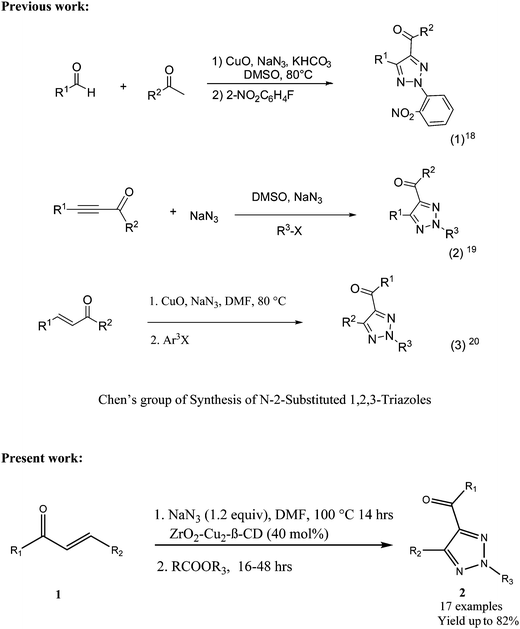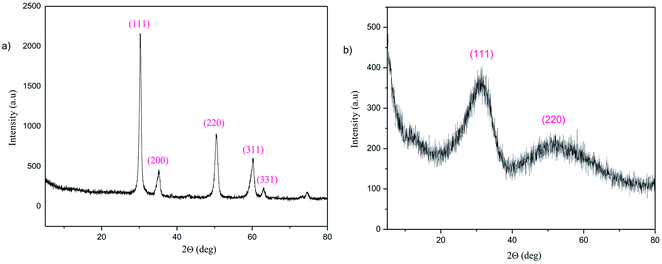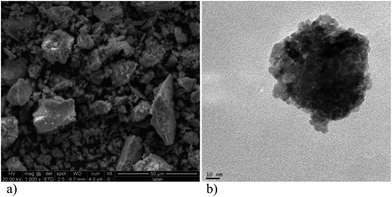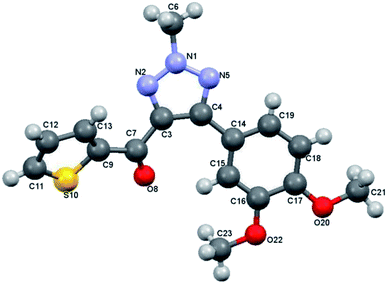ZrO2-supported Cu(II)–β-cyclodextrin complex: construction of 2,4,5-trisubstituted-1,2,3-triazoles via azide–chalcone oxidative cycloaddition and post-triazole alkylation†
Yarabally R. Girisha,
Kothanahally S. Sharath Kumara,
Umashankar Muddegowdab,
Neartur Krishnappagowda Lokanathc,
Kanchugarakoppal S. Rangappa*a and
Sheena Shashikanth*a
aDepartment of Studies in Chemistry, University of Mysore, Manasagangotri, Mysore-570006, India. E-mail: shashis1956@gmail.com; Tel: +91-821-2419668
bDepartment of Studies in Chemistry, KSOU, Mukthagangothri, Mysore-570006, India
cDepartment of Studies in Physics, University of Mysore, Manasagangotri, Mysore-570006, India
First published on 20th October 2014
Abstract
An efficient one-pot three-component stepwise approach for the synthesis of N-2-substituted-1,2,3-triazoles from chalcones, sodium azide and esters has been developed using a recoverable and reusable ZrO2 nanoparticle-supported Cu(II)–β-cyclodextrin complex as a catalyst. N-2 alkylation of triazoles using different aryl–alkyl esters without any additives has been achieved for the first time. The one-pot operation, atom-economical nature, regioselectivity and good yields are the noteworthy features of this protocol. The reusability of the prepared nanocatalyst was successfully examined four times without any appreciable loss in catalytic activity.
Introduction
During the last few decades, great attention has been given to click1 and green chemistry2 for the development of efficient, ecofriendly and environmentally benign protocols. Recently nano-particles in catalysis have emerged as a sustainable and competitive alternative to conventional catalysis. Specifically, nanoparticles supported on a metal oxide have been extensively studied in the field of medicine for drug delivery systems3 and for the detection of cancer cells in the early stages.4 Mesoporous nano-materials have also gained increasing importance in their use as catalysts in various organic reactions,5,6 as sensors for the detection of hydrazine,7 in optoelectronics,8 for enhancing up-conversion luminescence,9 and as electron transfer mediators in bio-electrochemical systems.10 The properties of metal oxide nanoparticles are very attractive compared to bulk catalysts due to their high surface to volume ratio and their surface atoms are more active and have attracted much attention because of wide spread applications in the fields of science and technology.11On the other hand, 1,2,3-triazoles are an important class of five membered nitrogen containing heterocycles which have wide spread applications in various fields including organic synthesis, pharmaceutical agents, agrochemicals, dyes, corrosion-inhibitors, photo stabilizers and photographic materials.12 1,3-dipolar cycloaddition of organic azides with alkynes via the Huisgen method is the most common approach for the synthesis of triazoles.13 However, the above said, this method suffers from serious drawbacks such as high temperature, low yields and low regioselectivity. In recent years, several research groups have reported a one-pot protocol for the synthesis of 1,2,3-triazoles using various copper catalysts,14 but the existing synthetic methodologies have mainly focused on N-1 substituted 1,2,3-triazoles.15
Only a few methods have been reported for N-2 substituted 1,2,3-triazoles.16 Generally, synthesis of N-2-substituted 1,2,3-triazoles is achieved from hydroxy ketones and hydrazine,17 but the synthesis of α-hydroxy ketone is a challenging task. In addition, several research groups have demonstrated different approaches for the synthesis of N-2-substituted 1,2,3-triazoles.18–23 Most of the reported methods suffer from serious drawbacks such as limited substrate scope, high temperature, long duration and using toxic reagents and non-economical chemicals like PdCl2. It is noteworthy to mention that none of the above mentioned literature methods have used esters as an alkylating agent. Therefore, the development of an efficient and safe protocol for the synthesis of N-2-substituted triazoles is still in demand. In this direction, for the first time, we have developed a one-pot protocol for the regioselective synthesis of 2,4,5-trisubstituted-1,2,3-triazoles via 1,3-dipolar cycloaddition using a novel ZrO2 nanoparticle supported Cu(II)–β-cyclodextrin complex (without any additives) followed by alkylation using esters as an alkylating agent in DMF at 100 °C (Scheme 1, eqn (4)). The main advantages of this protocol are the simple starting materials, one pot operation, easy workup procedure and high regioselectivity.
Results and discussion
The ZrO2 nanoparticle supported Cu(II)–β-cyclodextrin complex (ZrO2–Cu2–β-CD) was prepared by a simple one-pot co-precipitation method using ZrOCl2·8H2O, NH4OH and the Cu(II)–β-cyclodextrin complex (Scheme 2).24,25XRD analysis of ZrO2 and the ZrO2-nanoparticle supported Cu(II)–β-cyclodextrin complex indicates five characteristic peaks at 2θ = 30.2°, 35.15°, 50.44°, 60.14°, and 62.98° corresponding to (111), (200), (220), (311), and (331) planes, respectively, as shown in Fig. 1. All diffraction peaks and positions match those from the JCPDS card (Joint Committee on Powder Diffraction Standards no. 37-1484), calculated from the Scherrer’s equation,
SEM and TEM images of the prepared ZrO2–Cu2–β-CD nanoparticles of the ZrO2-supported Cu(II)–cyclodextrin complex are shown in Fig. 2. The TEM image of the catalyst shows that the nanoparticles are highly aggregated. The average size of these particles is about 1.2 nm, which shows a close agreement with the values calculated from XRD data. The SEM image of the supported catalyst confirms that these nanoparticles are unevenly sized due to deposition of Cu(II)–β-cyclodextrin complex nanoparticles on the surface of ZrO2, and most of them are almost spherical in shape.
The catalytic activity of the ZrO2–Cu2–β-CD nanoparticles was studied for the synthesis of 1,2,3-triazoles from chalcones. We initiated our studies with (E)-3-(4-ethylphenyl)-1-(thiophen-2-yl) prop-2-en-1-one (1h) as a representative substrate. Treatment of 1h and sodium azide with 40 mol% of ZrO2–Cu2–β-CD nanoparticles in DMF at 100 °C produced the triazole anion, and subsequent addition of 2-NO2-1,4-difluoro benzene afforded the N-2 arylated product in trace amounts. Furthermore, we carried out the reaction for N-2 substitution using different aryl halides like 1,4-dibromo and 1,4-dichloro benzenes, in both cases ending up with trace amounts of the N-2 arylated product. Then, accidentally, when we used 2-bromo-methyl benzoate for N-2-aryl substitution, the product spot was prominent in TLC; surprisingly, spectral analysis of the product confirms the N-methylated compound instead of the corresponding N-arylated product. Inspired by this finding, we elaborated to different esters for alkylation. We found, exclusively, the N-alkylated product in all cases without any traces of the N-arylated product (Table 1, entries 1–7).
| Entry | R | R3 | Yieldb (%) | Product |
|---|---|---|---|---|
| a 1h (1 mmol), NaN3 (1.2 mmol), 40 mol% of ZrO2–Cu2–β-CD (50 mg, 0.036 mmol) in DMF (3 mL) at 100 °C in air for 14 h first, then ester (1 mmol) was added to the mixture and the reaction continued for 16–48 h.b Isolated yields. | ||||
| 1 | CH3 | CH2CH3 | — | — |
| 2 | C6H5 | CH3 | 77 | 2k |
| 3 | C6H5 | CH2CH3 | 60 | 2n |
| 4 | C6H5 | Isopropyl | 52 | 2o |
| 5 | C6H5 | t-Butyl | 49 | 2p |
| 6 | C6H5 | n-Butyl | 46 | 2q |
| 7 | C6H5 | Isoamyl | 45 | 2s |
We then applied our interest to screen the reaction using different catalysts such as CuO, CuSO4, α-Fe3O4, ZrO2–β-CD, Cu2–β-CD, and ZrO2–Cu2–β-CD (Table 2, entries 1–15). Among all, ZrO2–Cu2–β-CD was found to be very effective for the formation of the N-2-alkylated product. CuO, CuSO4 and α-Fe3O4 gave only the triazole anion without undergoing N-alkylation. CuSO4 and Cu2–β-CD gave a mixture of products with low yields (Table 2, entries 2 and 5). We then screened the reaction using ZrO2–Cu2–β-CD as a catalyst with different solvents such as DMF, DMSO, EtOH and THF. Among them, DMF proved to be a better solvent for the formation of N-2-alkylated triazoles (Table 2, entry 9) at 100 °C.
| Entry | Catalyst | Temp (°C) | Mol% | Solvent | Time (h) | Yieldb (%) |
|---|---|---|---|---|---|---|
| a 1h (1 mmol), NaN3 (1.2 mmol), 40 mol% of ZrO2–Cu2–β-CD (50 mg, 0.036 mmol) in DMF (3 mL) at 100 °C in air for 14 h first, then 3-Cl–C6H4COOCH3 (1 mmol) was added to the mixture and the reaction continued for 16–48 h.b Isolated yields. | ||||||
| 1 | — | 125 | — | DMF | 24 | — |
| 2 | CuO | 125 | 10 | DMF | 18 | 50 |
| 3 | CuSO4 | 100 | 40 | DMF | 20 | 25 |
| 4 | α-Fe3O4 | 120 | 10 | DMSO | 20 | 50 |
| 5 | ZrO2–β-CD | 100 | 40 | DMF | 16 | 35 |
| 6 | Cu2–β-CD | 100 | 40 | DMF | 20 | 30 |
| 7 | ZrO2–Cu2–β-CD | 75 | 10 | DMF | 16 | 58 |
| 8 | ZrO2–Cu2–β-CD | 100 | 20 | DMF | 13 | 72 |
| 9 | ZrO2–Cu2–β-CD | 100 | 40 | DMF | 14 | 77 |
| 10 | ZrO2–Cu2–β-CD | 120 | 40 | DMF | 14 | 55 |
| 11 | CuO | 100 | 40 | DMF | 12 | 67 |
| 12 | ZrO2–Cu2–β-CD | 100 | 20 | EtOH | 13 | None |
| 13 | ZrO2–Cu2–β-CD | 100 | 20 | THF | 13 | None |
| 14 | ZrO2–Cu2–β-CD | 75 | 40 | DMF | 20 | 55 |
| 15 | CuO | 100 | 20 | DMF | 16 | 50 |
With the optimized reaction conditions in hand, we next explored the generality and scope of the protocol using several substituted aryl–alkyl esters (Table 3). The reaction of the 2,4,5 trisubstituted 1,2,3 triazole anion with an ester containing a chlorine atom at the m-position of the aryl group proceeded smoothly and regioselectively produced the corresponding 2,4,5-trisubstituted 1,2,3-triazole with an excellent yield (Table 3, entry 8). With methyl benzoate as an alkylating agent, a moderate yield of the desired product was observed (Table 3, entry 2) and the reaction with ethylbromoacetate yielded the expected product in good yield (Table 3, entry 3). When we carried out the reaction with different alkyl benzoates containing halogens at different positions the corresponding 2,4,5-trisubstituted 1,2,3-triazoles were produced with low yields (Table 3, entries 4–12). Disappointingly, 2-chloroethyl 3-chlorobenzoate did not promote the reaction (Table 3, entry 12).
| Entry | R | R3 | Yieldb (%) | Product |
|---|---|---|---|---|
| a 1d (1 mmol), NaN3 (1.2 mmol), 40 mol% of ZrO2–Cu2–β-CD (50 mg, 0.036 mmol) in DMF (3 mL) at 100 °C in air for 14 h first, then ester (1 mmol) was added to the mixture and the reaction continued for 16–48 h.b Isolated yields. | ||||
| 1 | CH3 | CH2CH3 | — | — |
| 2 | C6H5 | CH3 | 63 | 2m |
| 3 | BrCH2 | CH2CH3 | 78 | 2m |
| 4 | 2-BrC6H4 | CH3 | 53 | 2d |
| 5 | 2-IC6H4 | CH3 | Trace | 2d |
| 6 | 2-FC6H4 | CH3 | 44 | 2d |
| 7 | 2-ClC6H4 | CH3 | 60 | 2d |
| 8 | 3-ClC6H4 | CH3 | 81 | 2d |
| 9 | 4-ClC6H4 | CH3 | 57 | 2d |
| 10 | 2,4-ClC6H4 | CH3 | 58 | 2d |
| 11 | 3-ClC6H4 | CH2CH3 | 68 | 2m |
| 12 | 3-ClC6H4 | CH2CH2Cl | — | — |
Furthermore, varieties of chalcones were used to investigate the substrate scope of the reaction as shown in Table 4. Generally, chalcones with electron-withdrawing substituents at R1 and/or R2 led to higher yields (Table 4, entries 1–3, 6–12, 14–18 and 20). In contrast, chalcones bearing a thiophene ring gave moderate yields (Table 4, entries 1–3, 7–11, 14–18 and 20). When we used methyl 3-chlorobenzoate the reaction underwent substitution at a faster rate and we observed moderate to good yields (Table 4, entries 1–7, 9–12 and 14). With increasing alkyl chain length, as with isopropyl, t-butyl and isoamyl aromatic esters, the reactions proceeded more slowly with lower yields of the desired products (Table 4, entries 16–18, 20). When isopropyl 3-chlorobenzoate and phenyl 2,4-dichlorobenzoate were explored, only traces of the desired alkylated products were isolated.
| Entry | R1 | R2 | R3 | R | Time (h) | Yieldb (%) | Product |
|---|---|---|---|---|---|---|---|
| a Chalcone (1 mmol), NaN3 (1.2 mmol), 40 mol% of ZrO2–Cu2–β-CD (50 mg, 0.036 mmol) in DMF (3 mL) at 100 °C in air for 14 h first, then ester (1 mmol) was added to the mixture and the reaction continued for 16–48 h.b Isolated yields. | |||||||
| 1 | 2-Thiophenyl | 4-OCH3C6H4 | CH3 | 3-ClC6H4 | 16 | 80 | 2a |
| 2 | 2-Thiophenyl | 3,4-(OCH3)2C6H3 | CH3 | 3-ClC6H4 | 15 | 82 | 2b |
| 3 | 2-Thiophenyl | C6H5 | CH3 | 3-ClC6H4 | 16 | 76 | 2c |
| 4 | 4-OCH3C6H4 | C6H5 | CH3 | 3-ClC6H4 | 14 | 81 | 2d |
| 5 | 4-OCH3C6H4 | 4-CH3C6H4 | CH3 | 3-ClC6H4 | 15 | 82 | 2e |
| 6 | 4-OCH3C6H4 | 4-FC6H4 | CH3 | 3-ClC6H4 | 17 | 78 | 2f |
| 7 | 2-Thiophenyl | 4-FC6H4 | CH3 | 3-ClC6H4 | 18 | 72 | 2g |
| 8 | 2-Thiophenyl | 4-EthylC6H4 | CH2CH3 | BrCH2 | 12 | 79 | 2h |
| 9 | 2-Thiophenyl | 3,4,5-(OCH3)3C6H2 | CH3 | 3-ClC6H4 | 14 | 81 | 2i |
| 10 | 2-Thiophenyl | Benzo[1,3]dioxole | CH3 | 3-ClC6H4 | 16 | 75 | 2j |
| 11 | 2-Thiophenyl | 4-EthylC6H4 | CH3 | 3-ClC6H4 | 17 | 77 | 2k |
| 12 | 4-OCH3C6H4 | 4-BrC6H4 | CH3 | 3-ClC6H4 | 16 | 79 | 2l |
| 13 | 4-OCH3C6H4 | C6H5 | CH2CH3 | 3-ClC6H4 | 22 | 68 | 2m |
| 14 | 2-Thiophenyl | 4-FC6H4 | CH3 | C6H5 | 21 | 62 | 2g |
| 15 | 2-Thiophenyl | 4-EthylC6H4 | CH2CH3 | 3-ClC6H4 | 26 | 60 | 2n |
| 16 | 2-Thiophenyl | 4-EthylC6H4 | Isopropyl | 3-ClC6H4 | 30 | Trace | 2o |
| 17 | 2-Thiophenyl | 4-EthylC6H4 | t-Butyl | 3-ClC6H4 | 36 | 49 | 2p |
| 18 | 2-Thiophenyl | 4-EthylC6H4 | n-Butyl | 3-ClC6H4 | 32 | 46 | 2q |
| 19 | 4-OCH3C6H4 | C6H5 | C6H5 | 2,4-diClC6H4 | 48 | Trace | 2r |
| 20 | 2-Thiophenyl | 4-EthylC6H4 | Isoamyl | 3-ClC6H4 | 34 | 45 | 2s |
Finally, confirmation of the structure and the site of N-alkylation of the product were obtained by single crystal X-ray analysis of 2b, as shown in Fig. 3. The reusability of the ZrO2-supported Cu(II)–β-cyclodextrin nanoparticles has been studied. The ZrO2-supported Cu(II)–β-cyclodextrin nanoparticles were collected by filtration and washed four times with deionized water followed by methanol, dried in air and reused for the one-pot preparation of N-2-substituted 1,2,3-triazoles from chalcones. We haven’t found a noticeable decrease in the catalytic activity even after four catalytic cycles (Table 5).
| Cycle | Catalyst recovery (wt%) | Yield of 2a (%) |
|---|---|---|
| 1 | 90 | 81 |
| 2 | 88 | 79 |
| 3 | 87 | 77 |
| 4 | 85 | 74 |
Conclusion
We have developed an efficient ZrO2 nanoparticle-supported Cu(II)–β-cyclodextrin complex catalyzed protocol for regioselective synthesis of N-2-alkylated 1,2,3-triazoles with excellent yields from chalcones via cycloaddition and post-triazole alkylation using different aryl–alkyl esters without any additives for the first time. The regeneration of the ZrO2 nanoparticle-supported Cu(II)–β-cyclodextrin complex in situ by air oxidation is the advantage of our protocol and it reduces the catalyst load and increases the efficiency. The catalyst was collected easily by filtration and the reusability of the prepared nanocatalyst was successfully examined over four runs and was found to be effective up to four cycles with only a very slight loss of catalytic activity. This new, efficient, protocol offers several advantages over many of the previously published procedures. Interestingly, this method could be highly useful to synthetic as well as medicinal chemists for the regioselective derivation of a variety of N-2-substituted-1,2,3-triazole derivatives. The scope of this novel catalyst for the synthesis of other nitrogen containing heterocycles is being studied in our research group.Acknowledgements
YRG and KSS are thankful to UGC-BSR for meritorious fellowship Order no. DV-5/662/RFSMS/2012–13, New Delhi, India for financial support and we are also thankful to IOE, University of Mysore and NCBS, Bengaluru, Karnataka, India for their support in carrying out research work regarding the single crystal XRD and TEM analysis.References
- H. C. Kolb, M. G. Finn and K. B. Sharpless, Angew. Chem., Int. Ed., 2001, 40, 2004 CrossRef CAS.
- (a) R. A. Sheldon, I. Arends and U. Hanefeld, Green Chemistry and Catalysis, Wiley-VCH, Weinheim, 2007 RSC; (b) R. A. Sheldon, Chem. Commun., 2008, 29, 3352–3365 RSC; (c) P. Anastas and N. Eghbali, Chem. Soc. Rev., 2010, 39, 301 RSC.
- S. Tan, X. Li, Y. Guo and Z. Zhang, Nanoscale, 2013, 5, 860 RSC.
- K. T. Yong, I. Roy, M. T. Swihart and P. N. Prasad, J. Mater. Chem., 2009, 19, 4655 RSC.
- P. Song, D. Wen, Z. X. Guo and T. Korakianitis, Phys. Chem. Chem. Phys., 2008, 10, 5057 RSC.
- H. Y. Shi, B. Deng, S. L. Zhong, L. Wang and A. W. Xu, J. Mater. Chem., 2011, 21, 12309 RSC.
- (a) Y. Ding, Y. Wang, L. Zhang, H. Zhang, C. M. Li and Y. Lei, Nanoscale, 2011, 3, 1149 RSC; (b) O. A. Sadik, A. L. Zhou, S. Kikandi, N. Du, Q. Wang and K. Varner, J. Environ. Monit., 2009, 11, 1782 RSC; (c) X. D. Wang, O. S. Wolfbeis and J. R. Meier, Chem. Soc. Rev., 2013, 42, 7834 RSC.
- D. Jariwala, V. K. Sangwan, L. J. Lauhon, T. J. Marks and M. C. Hersam, Chem. Soc. Rev., 2013, 42, 2824 RSC.
- J. Liao, Z. Yang, H. Wu and D. Yan, et al., J. Mater. Chem. C, 2013, 1, 6541 RSC.
- H. Kang, Y. Zhu, X. Yang, J. Shen, C. Chen and C. Li, New J. Chem., 2010, 34, 2166 RSC.
- R. Narayanan and M. A. El-Sayed, J. Phys. Chem. B, 2005, 109, 12663 CrossRef CAS PubMed.
- (a) M. Whiting, J. Muldoon, Y.-C. Lin, S. M. Silverman, W. Lindstrom, A. J. Olson, H. C. Kolb, M. G. Finn, K. B. Sharpless, J. H. Elder and V. V. Fokin, Angew. Chem., Int. Ed., 2006, 45, 1435 CrossRef CAS PubMed; (b) H. C. Kolb and K. B. Sharpless, Drug Discovery Today, 2003, 8, 1128 CrossRef CAS; (c) M. J. Giffin, H. Heaslet, A. Brik, Y. C. Lin, G. Cauvi, C.-H. Wong, D. E. McRee, J. H. Elder, C. D. Stout and B. E. Torbett, J. Med. Chem., 2008, 51, 6263 CrossRef CAS PubMed; (d) W.-Q. Fann and A. R. Katritzky, in Comprehensive Heterocyclic Chemistry II, ed. A. R. Katritzky, C. W. Rees and E. F. V. Scriven, Elsevier Science, Oxford, 1996, vol. 4, p. 1 Search PubMed.
- R. Huisgen, in 1,3-Dipolar Cycloaddition Chemistry, ed. A. Padwa, Wiley, New York, 1984 Search PubMed.
- (a) C. Z. Tao, X. Cui, J. Li, A. X. Liu, L. Liu and Q. X. Guo, Tetrahedron Lett., 2007, 48, 3525 CrossRef CAS PubMed; (b) C. Zhang, B. Huang, Y. Chen and D. M. Cui, New J. Chem., 2013, 37, 2606 RSC; (c) S. Mohammed, A. K. Padala, B. A. Dar, B. Singh, B. Sreedhar, R. A. Vishwakarma and S. B. Bharate, Tetrahedron, 2012, 68, 8156 CrossRef CAS PubMed; (d) N. V. Dubrovina, L. Domke, I. A. Shuklov, A. Spannenberg, R. Franke, A. Villinger and A. Börner, Tetrahedron, 2013, 69, 8809 CrossRef CAS PubMed; (e) B. Kaboudin, Y. Abedi and T. Yokomatsu, Org. Biomol. Chem., 2012, 10, 4543 RSC; (f) B. Kaboudin, R. Mostafalu and T. Yokomatsu, Green Chem., 2013, 15, 2266 RSC; (g) S. Roy, T. Chatterjee and S. Manirul Islam, Green Chem., 2013, 15, 2532 RSC; (h) F. Alonso, Y. Moglie, G. Radivoy and M. Yus, Org. Biomol. Chem., 2011, 9, 6385 RSC; (i) N. Mukherjee, S. Ahammed, S. Bhadra and B. C. Ranu, Green Chem., 2013, 15, 389 RSC; (j) P. Abdulkin, Y. Moglie, B. R. Knappett, D. A. Jefferson, M. Yus, F. Alonso and A. E. H. Wheatley, Nanoscale, 2013, 5, 342 RSC; (k) P. Veerakumar, M. Velayudham, K. L. Lu and S. Rajagopal, Catal. Sci. Technol., 2011, 1, 1512 RSC.
- Selective methods of synthesizing N-1 substitued 1,2,3 triazoles: (a) C. W. Tornoe, C. Christensen and M. Meldal, J. Org. Chem., 2002, 67, 3057 CrossRef CAS PubMed; (b) V. V. Rostovtsev, L. G. Green, V. V. Fokin and K. B. Sharpless, Angew. Chem., Int. Ed., 2002, 41, 2596 CrossRef CAS; (c) D. Yang, N. Fu, Z. Liu, Y. Li and B. Chen, Synlett, 2007, 278 CAS; (d) M. M. Majireck and S. Weinreb, J. Org. Chem., 2006, 71, 8680 CrossRef CAS PubMed; (e) C. Spiteri and J. E. Moses, Angew. Chem., Int. Ed., 2010, 49, 31 CrossRef CAS PubMed; (f) F. Shi, J. P. Waldo, Y. Chen and R. C. Larock, Org. Lett., 2008, 10, 2409 CrossRef CAS PubMed; (g) V. Aucagne and D. A. Leigh, Org. Lett., 2006, 8, 4505 CrossRef CAS PubMed; (h) B. Sreedhar, P. S. Reddy and V. R. Krishna, Tetrahedron Lett., 2007, 48, 5831 CrossRef CAS PubMed; (i) W. Qian, D. Winternheimer and J. Allen, Org. Lett., 2011, 13, 1682 CrossRef CAS PubMed.
- Methods of regioselectively synthesizing N-2 substitued 1,2,3 triazoles: (a) S. Kamijo, T. Jin, Z. Huo and Y. Yamamoto, J. Am. Chem. Soc., 2003, 125, 7786 CrossRef CAS PubMed; (b) Y. Chen, Y. Liu, J. L. Petersena and X. Shi, Chem. Commun., 2008, 28, 3254 RSC; (c) J. Kalisiak, K. B. Sharpless and V. V. Fokin, Org. Lett., 2008, 10, 3171 CrossRef CAS PubMed; (d) Y. Liu, W. Yan, Y. Chen, J. L. Petersen and X. Shi, Org. Lett., 2008, 10, 5389 CrossRef CAS PubMed; (e) X. Wang, L. Zhang, H. Lee, N. Haddad, D. Krishnamurthy and C. H. Senanayake, Org. Lett., 2009, 11, 5026 CrossRef CAS PubMed; (f) X. J. Wang, L. Zhang, D. Krishnamurthy, C. H. Senanayake and P. Wipf, Org. Lett., 2010, 12, 4632 CrossRef CAS PubMed; (g) L. Zhang, Z. B. Li, X. J. Wang, N. Yee and C. H. Senanayske, Synlett, 2012, 23, 1052 CrossRef CAS PubMed; (h) M. G. Murali and P. Tharmalingam, J. Org. Chem., 2012, 77, 5063 CrossRef PubMed; (i) K. S. Mariola, M. P. Ewa and R. Tomasz, Tetrahedron, 2012, 68, 214–225 CrossRef PubMed; (j) W. M. Yan, T. Liao, O. Tuguldur, C. Zhong, J. L. Petersen and X. D. Shi, Chem.–Asian J., 2011, 6, 2720 CrossRef CAS PubMed; (k) A. Kamal and P. Swapna, RSC Adv., 2013, 3, 7419 RSC.
- K. S. Balachandran, I. Hiryakkanavar and M. V. George, Tetrahedron, 1975, 31, 1171 CrossRef CAS.
- X. Liu, X. Li, Y. Chen, D. Wang, J. Chen and B. Chen, Asian J. Org. Chem., 2013, 2, 212 CrossRef CAS.
- J. Li, Y. Zhang, D. Wang, W. Wang, T. Gao, L. Wang, J. Li, G. Huang and B. Chen, Synlett, 2010, 1622 Search PubMed.
- Y. Zhang, X. Li, J. Li, J. Chen, X. Meng, M. Zhao and B. Chen, Org. Lett., 2012, 14, 26 CrossRef CAS PubMed.
- X. Liu and J. Li, New J. Chem., 2013, 37, 965 RSC.
- S. Kamijo, T. Jin, Z. Huo and Y. Yamamoto, J. Am. Chem. Soc., 2003, 125, 7786 CrossRef CAS PubMed.
- M. Koszytkowska-Stawinska, E. Mironiuk-Puchalska and T. Rowicki, Tetrahedron, 2012, 68, 214 CrossRef CAS PubMed.
- Y. Matsui, T. Kurita and Y. Date, Bull. Chem. Soc. Jpn., 1972, 45, 3229 CrossRef CAS.
- L. Bai, A. F. Wyrwalski, C. Machut, P. Roussel, E. Monflier and A. Ponchel, CrystEngComm, 2013, 15, 2076 RSC.
Footnote |
| † Electronic supplementary information (ESI) available. CCDC 1009982. For ESI and crystallographic data in CIF or other electronic format see DOI: 10.1039/c4ra09970b |
| This journal is © The Royal Society of Chemistry 2014 |










